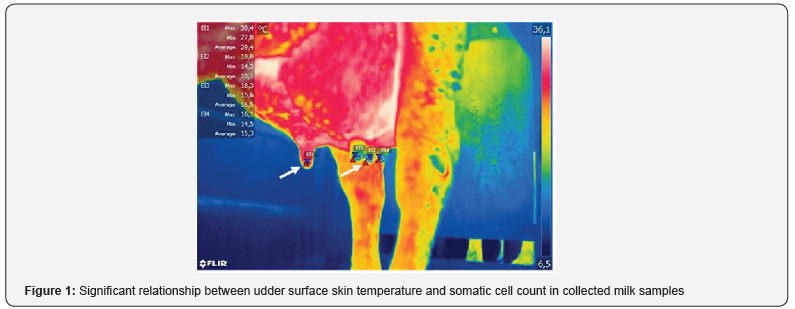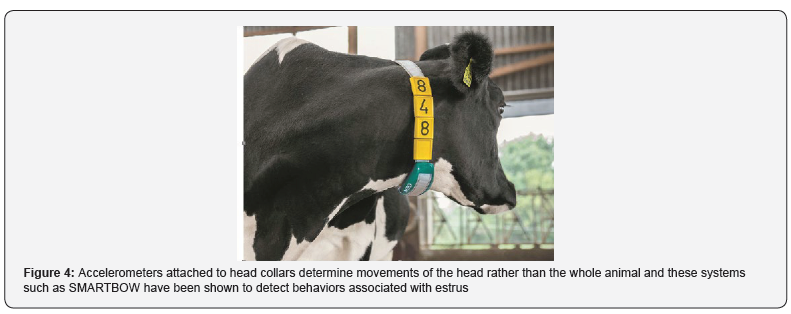Dairy & Veterinary Sciences - Juniper Publishers
Introduction
In an industry as highly competitive as agriculture, the perpetually increasing pressure to produce cheaper sources of protein is further suffocating already meagre profit margins. In the past decade, in particular, a surge in the number of commercially available precision-farming products, utilising technologies common to the research sector are helping some farmers transform their business operations. Wearable technologies have become commonplace on farms looking to gain a competitive edge. Cow collars, anklets, smart ear-tags and indwelling rumen-boluses take advantage of low-cost, mass-produced sensor components to offer multi-faceted health-monitoring solutions. Accelerometers monitor animal movement, gyroscope sensors record ruminal contractions, ion-sensitive glass electrodes track fluctuations in rumen pH, thermistors and thermocouples register temperature and Bluetooth or radiotelemetric elements transmit data to receiver stations which push data up to the cloud for analysis, interpretation and translation into useable information for clients. In addition, with continued research into the use of infrared-thermography, along with computer-vision and artificially intelligent machine-learning technologies for use in animal health monitoring and biometric analysis, it is likely that we will continue to see an increase in monitoring technologies of an even less-invasive nature.
Proposed benefits
Electronic identification (EID) technologies are commonly incorporated into livestock monitoring devices and provide an easily accessible method of monitoring multiple performance parameters for individual animals. Data gathered from smart- devices or machinery can be analysed to highlight areas where the farm is excelling or where practices need adjustment. The value of single animals can also be analysed and poor performing members can be removed from the herd.
The benefits of precision-farming technologies appear obvious; earlier disease detection is particularly beneficial in large herds where animals are not examined regularly on an individual basis or where there is a high risk of contagion. Rumination, recumbency and pH monitoring are being used to the benefit of the farmer to detect metabolic disorders such as subacute ruminal acidosis and infrared thermography has the ability to detect subtle changes in body temperature, indicating a departure from good health. This can be particularly useful in the detection of diseases such as mastitis, which costs the US dairy industry an estimated $2 billion annually, or about 11% of total U.S. milk production quite apart from the great concern in terms of animal welfare. A study of infrared thermography on dairy farms [1] (Figure 1) showed a significant relationship between udder surface skin temperature and somatic cell count in collected milk samples. Sensitivity and specificity in the classification of udder health were: 78.6% and 77.9%, respectively [2]. These may seem relatively low but given the ease of imaging udders versus obtaining somatic cell counts, they are an excellent start in evaluating udder health.
Where else might we see an increase in temperature in inflamed tissue? Ompahilitis in newborn calves is a significant health issue One recent study showed the maximum temperature of the lateral umbilical region in calves aged less than 30 days to be 35.7 ±1.8°C in a control group of calves and 37.0±1.1°C in the omphalitis group this being significantly different at p = 0.002 [3]. Given the low cost of handheld non-contact thermal imagers this would be a very valuable tool for diagnosis by the farmer of umbilical infection in young calves.




Lameness is a common affliction in dairy herds and is responsible for 10.4% of all dairy cows culled in the UK [4]. The cost of replacements is high and therefore early detection of the condition is critical so that swift treatment and resolution can occur. This not only has positive welfare benefits for the animal but saves the farmer direct costs associated with culling and the indirect costs associated with rearing a replacement heifer. Thermography to detect hoof lesions associated with lameness by measuring the changes in coronary band and hoof skin surface temperature can be really valuable (Figure 2) [5]. Perhaps more helpful is digital technology detecting changes in locomotion. Accelerometers (Figure 3) can readily detect changes in locomotion significantly earlier than simple human observation shows a lameness to be developing [6] and software packages such as Cow-Gait have been developed to monitor locomotion [7]. But as Alsaaod and colleagues have noted [8] technology to detect lameness and develop algorithms in evaluating locomotor data is widely discussed but we have very few papers documenting decisions over when to act in individual animals with subclinical lameness.
Accurate estrus detection too is critical to a dairy enterprise. Visual assessment is not always reliable, bulling cows are easily missed when not being directly observed and each unnoticed estrus period results in a 21-day extension to an animal’s calving interval. The advent of modern technology allows signs of oestrus to be recorded and alerts sent to the farmer or technician performing artificial insemination (AI), along with a time that is best to serve the cow, resulting in increased conception rates. Similarly, detection of calving is equally important should the animal need assistance as the loss of a calf due to avoidable circumstances is particularly disappointing. Accelerometers attached to head collars (Figure 4) determine movements of the head rather than the whole animal and these systems such as SMARTBOW have been shown to detect behaviours associated with estrus [9]. Thermography can be a useful tool also – in one study nine anatomical locations (vulva area, tail head, muzzle, front feet, rump, cheek, neck, and withers) but not eye or flank exhibited an increase in radiated temperature during the last 48 h before estrus [10].
Dealing with Data
The amount of information obtained from a set of monitoring devices from thermal imaging, movement detection, ruminal boluses and so on can be large to the extent of being completely unmanagemeable. Here the employment of artificial intelligence is crucial [11,12]. Machine learning can allow appropriate weighting of data regarding milk composition and electrical conductivity to detect subclinical mastitis, a huge problem in the dairy industry. Lactoferrin concentration, sodium levels and protein concentration were found mlore predictive in one study than data such as concentration and milk yield [13].
Potential Drawbacks
Drawbacks to precision farming technologies are limited but noteworthy. Devices incorporate a host of technologies as discussed above, but as of yet, there is no unified solutions capable of recording all of the measurable parameters already discussed, only a combination. Each company producing such wearable devices is fighting for a market share and is in control of data gathered through their devices. Analysis and interpretation of said data will vary. There are currently no standards governing analysis techniques concerned with livestock monitoring data, which involves the use of multiple algorithms [1] and evidence suggests that the interpretation of this data can be quite varied [2].
Mobile monitoring devices are susceptible to physical damage, environmental exposure and failure of transmitter or sensor components. Battery life varies greatly between devices and is a key consideration when selecting a compatible solution as device initial purchase outlays are often considerable and even costprohibitive for many farmers.
A last potential deleterious effect is that too great a reliance on technology may lead to farmers paying much less attention to their animals with a reduction in welfare. Having said that the 24:7 ability to monitor the cattle and the use of AI (artificial intelligence not insemination in this case!) to correlate the data arising from the digital technology noted above can only be of benefit to the animals. A herdsman’s ‘gut feeling’ about the state of his or her animals has always been seen as a key part of dairy farming but detailed information about locomotion, behavioural changes, body temperature or changes occurring in disease cannot be anything but beneficial.
To Know more about Dairy & Veterinary Sciences
Click here: https://juniperpublishers.com/index.php





No comments:
Post a Comment